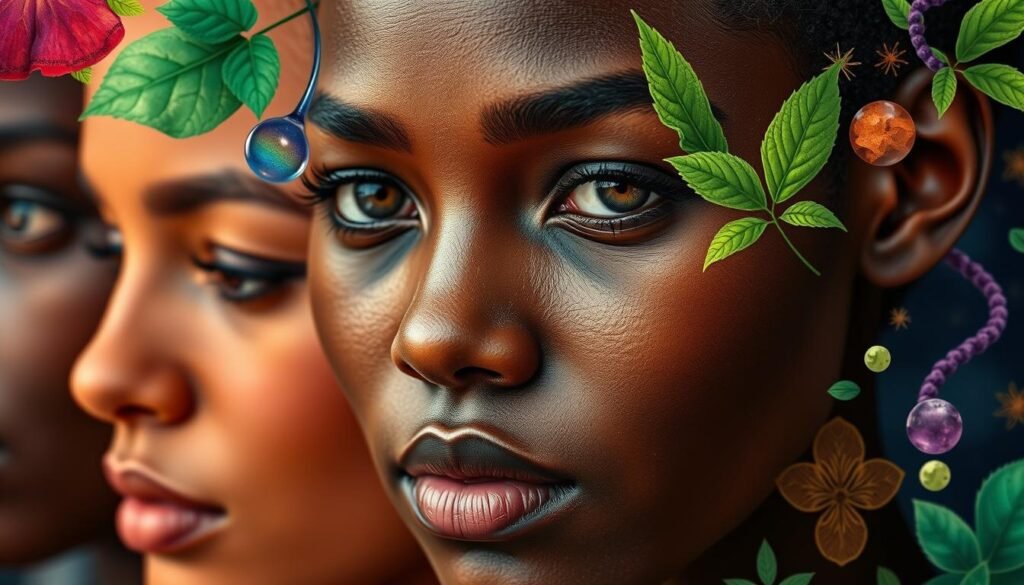Whole oranges are a nutritional powerhouse, giving you health benefits that go beyond orange juice.…
Read More →

Whole oranges are a nutritional powerhouse, giving you health benefits that go beyond orange juice.…
Read More →
To say we’re more obsessed with bareMinerals’ founder Leslie Blodgett than we are with the…
Read More →
In the world of mental health, the stress response called functional freeze is often not…
Read More →
Marlyn Alarm is a singer from Miami, Fla., undergoing formal gender transition after living a…
Read More →
The duchess brought her little one to Snettisham Park in the UK over Easter weekend,…
Read More →The science of human skin color is complex and fascinating. It’s all about melanin variations. Melanin is the pigment that gives us our skin color. Its different forms explain why we have so many skin tones.
Studying melanin variations helps us understand what makes us unique. It shows that melanin changes are a natural part of our diversity. They help shape our individual traits.
Melanin is a complex pigment that affects human skin color. It’s made by cells called melanocytes and influences skin, hair, and eye color. The way melanin is made has changed over time to fit different environments.
The color of human skin comes from melanin and other factors like genetics and environment. Skin pigmentation is key to understanding human biology. Melanin not only affects skin color but also protects it from UV radiation.
Melanin is a pigment made by melanocytes. There are two main types in human skin: eumelanin and pheomelanin. Eumelanin causes brown and black colors, while pheomelanin results in red and yellow.
The mix of eumelanin and pheomelanin creates various skin colors. More eumelanin means darker skin, and more pheomelanin means lighter skin.
The evolution of melanin is linked to human skin color. Different groups have unique melanin profiles based on their environments. For example, people near the equator have more melanin to block strong sunlight.
Understanding melanin is key to seeing the diversity in human biology. By studying it, we learn about the complex interactions between genetics, environment, and biology that shape our skin colors.
| Type of Melanin | Color Produced |
|---|---|
| Eumelanin | Brown and Black |
| Pheomelanin | Red and Yellow |
Human skin color comes from many genes and outside factors. Melanin, the main pigment, is key. It’s made by the hormone MSH from the pituitary gland. More melanin means darker skin, less means lighter.
The way skin color forms is linked to melanin production. This is vital for protecting against UV radiation. The human skin can change to fit its environment, thanks to skin color formation. Knowing how skin color forms helps us understand human diversity and the role of melanin production in keeping skin healthy.
Several things affect skin color formation:
In summary, skin color formation is complex, involving melanin production, genetics, environment, and hormones. Knowing these factors helps us see the beauty of human skin diversity and why melanin production is vital for healthy human skin.
| Factor | Influence on Skin Color Formation |
|---|---|
| Genetic factors | Determine the amount and type of melanin produced |
| Environmental factors | Stimulate melanin production in response to UV radiation |
| Hormonal factors | Regulate melanin production through the hormone MSH |
Melanin variations are complex, influenced by genetics and environment. The pigment melanin, which gives skin its color, is shaped by genetics and environment. Genetic factors like mutations in the MC1R gene can lead to different skin colors, from very fair to very dark.
Environmental factors, like UV radiation, also affect melanin variations. More UV exposure means more melanin, making skin darker. This helps protect the skin from UV damage.
Genetics play a big role in melanin variations. Studies have found genes like MC1R that affect melanin production. These genes can change how much and what type of melanin is made, leading to various skin colors.
Environmental factors, like UV radiation, also shape melanin production. The spread of melanin variations across the globe shows how humans adapted to their environments. Different populations developed unique melanin profiles to suit their surroundings.
The spread of melanin variations shows the mix of genetics and environment. Near the equator, where UV is strong, people have darker skin to protect themselves. In areas with less UV, people have lighter skin.
Understanding melanin variations helps us appreciate human skin color diversity. Recognizing how genetics and environment interact shows the unique traits of each person.
| Genetic Factor | Environmental Influence | Geographic Distribution |
|---|---|---|
| MC1R gene mutations | UV radiation | Equatorial regions |
| TYR gene mutations | Climate | Temperate regions |
| ASIP gene mutations | Latitude | Polar regions |
Melanocytes are the cells that make melanin in our skin. They decide our skin color. These cells live in the epidermis, the skin’s outer layer. They make melanin when they get hormonal signals.
Melanocytes work with keratinocytes, the main skin cells, to color our skin. Melanin moves from melanocytes to keratinocytes. Then, it spreads all over our skin.
Many things can change how melanin is made. Genetic factors and environmental factors like UV rays play a big role. Knowing how melanocytes work helps us understand skin color and how it changes.
These factors can change how much melanin we make. This leads to different skin colors. By learning about melanocytes, we see how complex skin color is.
Melanocytes also protect our skin from UV damage. Melanin acts like a sunscreen, blocking UV rays. This shows how important melanocytes are for keeping our skin healthy.
When we get sunlight, UV radiation affects our skin. It makes our skin produce more melanin. This is why we often get a tan when we’re in the sun.
UV radiation is key in making more melanin. When our skin gets UV radiation, it starts making more melanin. This makes our skin darker.
Melanin levels change with the seasons. In summer, more melanin is made because of more sun. In winter, there’s less melanin because of less sun.
Melanin helps protect us from UV radiation. It absorbs and scatters UV radiation to keep our skin safe. This is important for healthy skin and preventing sunburn and skin cancer.
| Season | Melanin Levels | UV Radiation Exposure |
|---|---|---|
| Summer | High | High |
| Winter | Low | Low |
Melanin is key to human health, not just for skin color. It helps control hormone levels, boosts the immune system, and fights off cell damage. Knowing how melanin keeps us healthy is vital.
Here are some ways melanin affects human health:

Melanin is also linked to diseases like melanoma, vitiligo, and albinism. More research is needed to understand its role in human health and skin color.
| Disease | Description |
|---|---|
| Melanoma | A type of skin cancer that affects melanin-producing cells |
| Vitiligo | A condition that causes loss of melanin-producing cells, leading to white patches on the skin |
| Albinism | A condition that affects the production of melanin, resulting in little to no pigmentation in the skin, hair, and eyes |
Human skin pigmentation has changed a lot over time. This change was driven by evolution and natural selection. As people moved to different places, their skin color changed to fit the local environment. This led to many different skin colors around the world.
Natural selection played a big role in changing skin color. In sunny places, people with more melanin were better protected from harmful UV rays. This led to darker skin in these areas. In places with less sun, people with less melanin were favored, leading to lighter skin.
Scientists are studying how human skin pigmentation evolved. They use genetic analysis and computer models to understand the complex factors at play. By looking at how skin pigmentation evolved, we can learn more about human history and evolution.
Melanin levels are key to human health, mainly in fighting skin cancer. People with less melanin face a higher risk of skin cancer. This is because they have less protection against harmful UV rays. Yet, those with more melanin might struggle with vitamin D deficiency. This is because melanin can block vitamin D production.
It’s vital to grasp the health effects of melanin levels to stay healthy and avoid diseases linked to melanin imbalances. Important points to remember include:
Knowing the health risks of melanin levels and acting early can lower the risk of health problems. It’s important to balance skin protection from UV rays and vitamin D production. Both are critical for good health and skin cancer prevention.
Skin pigmentation has shaped cultural and social norms for centuries. It deeply influences how people see and treat each other. Different societies have their own values and beliefs about skin color.
In the past, skin color was tied to social status. Lighter skin was seen as wealthier. But today, we celebrate our diversity. We embrace our unique skin colors and push for inclusivity.
Historically, skin color decided social rank. Lighter skin meant power and influence. This created a complex relationship between skin color and status.
Now, we see skin pigmentation in a new light. We value the beauty and diversity of all skin colors. This change comes from understanding the cultural importance of skin pigmentation and the need for inclusivity.
Celebrating diversity is key to inclusivity. By valuing unique skin colors and backgrounds, we build a better society. Education and community efforts help us understand and appreciate skin pigmentation’s role in our culture.

Together, we can celebrate diversity and inclusivity. This way, we build a society where everyone is valued and respected, no matter their skin color or background.
Recent years have brought big steps forward in melanin research. We now know more about its role in our health and biology. These discoveries open up new paths for research, looking into how melanin can help us.
Studies on melanin could lead to big changes in medicine, beauty products, and materials science. This is because melanin is found in our skin and plays a key role in how we react to the sun.
Some key areas of focus in melanin research include:
As researchers learn more about melanin, we can look forward to new discoveries. They aim to use these findings to help us better understand melanin’s role in our health. The future of melanin research is bright, with many possibilities waiting to be explored.
By exploring these areas, we can learn more about how melanin works with our environment and health. This knowledge will help us create new treatments and materials. It’s all thanks to the latest scientific breakthroughs in melanin research.
Human diversity is a complex and beautiful thing. It shows in the wide range of skin colors around the world. Each skin color is special and adds to the rich mix of human diversity.
Beauty is often linked to skin color, with different cultures having their own views. But beauty goes beyond one skin color. Embracing and celebrating this diversity helps us be more inclusive and accepting.
Here are some ways to appreciate human diversity and beauty:
By valuing human diversity, we can build a more welcoming society. A place where everyone feels valued, no matter their skin color or background.
As we wrap up our exploration of melanin and human skin color, it’s clear this topic is more than science. It’s a celebration of the amazing diversity that makes us unique. Melanin, the pigment that gives us our skin tones, shows how adaptable and resilient humans are.
Learning about melanin helps us appreciate the wide range of skin colors around the world. From the dark skin of the equator to the light skin of the north, each color tells a story. It reflects a person’s ancestry and the environment they came from.
Now, it’s up to us to understand and celebrate this diversity. By embracing the melanin variations that make up the human skin color spectrum, we can overcome prejudice. We can celebrate the incredible richness of our shared humanity.
